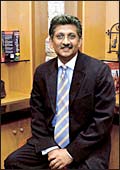 |
BIG BAZAAR
Biyani's hypermarket chain has been a hit with middle-class
consumers |
 |
WESTSIDE
The Tatas' departmental store chain plans to expand
to 100 stores by 2007 |
A
state-owned cooperative retail chain launching revamped stores
doesn't usually cause a stir in industry. Yet, when the loss-making
Sahakari Bhandar opened the doors to its new-look stores in Mumbai
on May 4th, there were many willing to swear that they had peered
into the future of Indian retail. Behind the innocuous relaunch
was the might of Mukesh Ambani's Reliance Industries, which has
retail plans big enough to make Wal-Mart's Lee Scott sit up and
take note (about that in a bit). Sahakari Bhandar, which has outsourced
supply chain management to Reliance, is a proving ground of sorts
for the private sector conglomerate. If the relaunch is any indication,
then Reliance may be proving a bright student of the trade. For
starters, the new Bhandars are swank with smartly turned out sales
staff. There's a wide variety of products-ranging from groceries
and frozen foods to household care and, surprise, music and films-ambience
and hygiene have dramatically improved, and although there's no
Reliance logo anywhere in the stores, the stamp of professionalism
is everywhere.
Welcome to the brave new world of Indian
retail, where new entrants such as Reliance and Bharti, besides
many existing and future foreign retailers, will jockey with early
birds like Kishore Biyani's Pantaloon Retail (now Future Group),
K. Raheja Group's Shoppers' Stop, Tata Group's Trent, RPG's Spencer's
and Micky Jagtiani-owned Landmark Group's Lifestyle stores, for
a piece of the Indian consumer's swelling wallet.
To be sure, there's plenty of room for all.
Organised retail in India today is virgin territory and the possibilities
are limited by nothing, but the entrepreneur's own gumption. Consider
the facts: According to various estimates, the overall retail
industry in India is $206-350 billion-big (Rs 9,30,000-15,75,000
crore), but 3 per cent or less of it belongs to organised retail.
There are more than 10 million kirana, or mom-n-pop, stores in
the country, compared to less than 3,000 modern format ones. More
importantly, if the economy maintains its pace, consumption could
go up by another $157 billion (Rs 7,06,500 crore), according to
estimates by Technopak, a Delhi-based consulting firm. With the
result, the organised retail pie could swell to $30 billion (Rs
1,35,000 crore) by 2010, Ernst & Young estimates. Says Harminder
Sahni, coo, Technopak: "Companies are in such a hurry that
they aren't even waiting for detailed project reports before they
start work. Everyone realises that time is of essence."
NEW, BUT BIG
Reliance has the biggest retail investment
plan by far. |
|
|
| Reliance's Mukesh Ambani: Plans
to emerge as the biggest player by getting into a range
of retail formats |
|
Investment Planned: Rs
3,375 crore initially, going up to
Rs 15,000 crore by 2007-08
Formats: Everything from hypermarkets to agri-products
to consumer electronics
Stores: 1,575 by March 2007
Turnover Target: Rs 90,000 crore by 2010
|
Big and small companies are literally scrambling
to grab a piece of the retail gold mine. Reliance Retail (as it
is likely to be called) wants to carpet bomb the industry with
an initial investment plan of Rs 3,375 crore, going into everything
from hypermarkets, supermarkets, convenience stores to produce
exports. Eventually, which apparently means by April 2008, it
hopes to sink in a staggering Rs 15,000 crore into retail. It
has already brought on board some heavyweights from different
industries, including Raghu Pillai from Pantaloon Retail, Gunender
Kapur (Unilever), Rajeev Karwal (Electrolux) and Sriram Srinivasan
(Indus League), among others. According to one report, Reliance
Retail has even placed orders for five Boeing cargo planes to
ferry perishable items from remote warehouses to its stores. The
launch of the first Reliance store, a hypermarket, is expected
in Ahmedabad during the last quarter of this calendar.
POPULAR FORMATS
There's plenty of room for innovation,
but most investment will go into hypermarkets and supermarkets.
|
| Format/ Nature Of Retail
Hypermarket: This is the mother of all retail formats
and offers everything from foods to dry grocery to hardware
to electronics. Typically, would span more than 100,000
sq. ft of space, and be located outside of the city centre.
Pantaloon's Big Bazaar, Spencer's Hypermarket and Trent's
Star India fit this category.
Supermarket: It is focussed on foods, grocery and
household items, and located in residential areas. FoodWorld
is an example of this.
Departmental Store: Like the name reveals, this
format carries various 'departments' such as apparel, houseware,
furniture, jewellery and appliances, but is much smaller
than a hypermarket in terms of space and SKUs (stock keeping
units). Shoppers' Stop, Westside and Lifestyle are three
such stores.
Convenience Store: Accessibility is what this format
offers and, therefore, is conveniently located in crowded
neighbourhoods. Think Nilgiri's in South, and 24/7 in Delhi.
Exclusive Outlet: It stocks a single brand, and
could be either company-owned or franchised. Everyone from
Raymond and Madura Garments to LG and Samsung to Maruti
and Hyundai have it.
Discount Store: This format's proposition is that
it offers no frills such as spacious, well-lit and air-conditioned
retail space, but makes up by marking down MRP (maximum
retail price). South's Subhiksha is the best-known example
of it in India.
Cash-n-carry: This is a B2B format, where the retailer
sells to shopping establishments and large institutional
customers. Metro in Bangalore is a cash-n-carry.
|
 |
SAHAKARI BHANDAR
Reliance, it seems, has decided to learn the ropes
at the state-owned retailer |
Telecoms giant Bharti, which already has a
joint venture with the el Rothschild Group-controlled, ELRO Holdings
India for exporting produce under the FieldFresh brand (Reliance
has a Jamnagar Farms too), is said to be talking to three or four
foreign retailers, including Wal-Mart, Tesco and Carrefour. "We
are looking at all possible models and formats," says Rajan
Mittal, a promoter family member and head of the retail foray,
"and we'll be in a position to unveil our plans over the
next four to six months." The Tatas aren't just expanding
their Westside and Star India Bazaar chains, but also are said
to be in talks with Home Depot for a tie-up. Similarly, the K.
Raheja Group-promoted Shoppers' Stop and brand new hypermarket
HyperCITY have ambitious expansion plans. Meanwhile, the current
king of organised retail in India, Pantaloon's Kishore Biyani,
has a Reliance-like carpet bombing strategy, but on a vastly smaller
scale. He plans to invest Rs 500 crore by next April in growing
his hypermarket chain Big Bazaar and apparel chain, Pantaloon
(see Supersize Me). "Our intention," says Biyani, "is
to be in the consumption space. We have completed the process
of getting into new categories, though we will continue to look
for more opportunities."
 |
 |
 |
 |
Pantaloon's Biyani:
Plans to invest Rs 500 crore by April 2007 to grow
his Big Bazaar and Pantaloon chains |
Trent's Noel Tata:
He's added hypermarkets (Star Bazaar) and music &
book stores (Landmark) to his growing retail business |
Shoppers' B.S. Nagesh: He
was the first to launch a retail chain in 1994. By 2008, he'll
have 39 Shoppers' Stops |
Bharti's Rajan Mittal:
He spearheads the telco's foray into retail, and is
currently looking at all formats and talking to foreign players
for a tie-up |
Experimentation Galore
There's so much happening in retail that
it's near impossible to list in a few pages what each one of the
players is trying to do (that, in any case, is not the idea behind
this survey). What's evident, though, is that the 12-year-old
organised retail industry (Shoppers' Stop was the first launch
way back in 1994) has entered a phase of super-heated growth.
According to Technopak, $12 billion (Rs 54,000 crore) may get
invested in retail over the next five years. Where will all that
money go? Most likely into two of the most popular formats: Hypermarkets
and supermarkets. In terms of product categories, half of the
investment could be in food-related retail and the other half
in non-food. The bias towards foods is easily explained. About
11 per cent of the organised retail sales come from foods and
groceries, with apparel and consumer durables accounting for 39
per cent and 9 per cent, respectively (see The Organised Retail
Pie). That, then, is 60 per cent of the market.
| ONLINE RETAIL: HANGING FIRE |
|
With 50 million internet users,
India recently overtook Germany as the fourth largest online
nation (the US, China and Japan are ahead). That number
could double over the next two years. So online retail should
be booming, right? Not really. Just 7 per cent of India's
net users shop online and when they do, they are usually
buying travel services, books, or electronic items, besides
doing online banking. Remove travel-related transactions
and online banking, and the Rs 1,500-crore market shrinks
to Rs 100 crore. That hasn't deterred Future Group's Kishore
Biyani from planning an online store (www.futurebazaar.com).
Neither has India's online retail pioneer Fabmall, which
also has brick-n-mortar stores, given up hope. "The
triggers for growth are plenty and I expect online retail
to witness explosive growth," says K. Vaitheeswaran,
Fabmall's COO.
-Venkatesha Babu
|
However, there will be plenty of formats in
between hypermarkets and supermarkets. For instance, the Godrej
Group runs a rural retail chain called Aadhar, which started off
selling animal feed and fertiliser to farmers, but now also vends
tractors and durables, and Nature's Basket, which retails fruits
and vegetables. DCM Shriram Consolidated, too, operates a Hariyali
Kisan Bazaar, which delivers a range of farm inputs. There are
24 such stores at the moment, but the company plans to open 500
centres in another five years. There will be several more niche
retail chains such as these. Shoppers' Stop has launched a food
and beverage chain called Brio, with an outlet each in Bangalore
and Mumbai. "The dream is to make a billion-dollar company
out of Shoppers' Stop," quips CEO Govind Shrikhande. Metro
is a (cash-n-carry) retailer that only sells to businesses, while
southern retailer Subhiksha has developed its own unique discount
store format. Says Ireena Vittal, Partner, McKinsey & Co.:
"The Indian organised retail industry is entering a phase
of experimentation. Most of the local players don't have any historical
experience of running a retail business, but they are very comfortable
experimenting."
Perhaps the best example of an experimental
retailer is Pantaloon's Biyani. In the eight years that he's been
in the business, Biyani has built a retail empire with an astonishing
variety of interests. He's into hypermarkets, malls (Central,
and he recently acquired Crossroads from the Piramals) and apparel
manufacturing, among others. Even the Tatas have diversified from
departmental stores (Westside) to hypermarkets (Star Bazaar India),
to books and music (via Landmark, where they acquired a 76 per
cent stake last year.) Some day in the future, the retailers will
want to consolidate and get out of areas where they don't have
a clear advantage. But for now, everyone will want to do everything,
simply because opportunities exist. Says Adi Godrej, Chairman,
Godrej Group, "The market is largely underpenetrated, which
means there can only be new opportunities."
| REAL ESTATE AND MALL ECONOMICS |
 |
CROSSROADS
Biyani paid a cool Rs 250 crore to buy this
mall from the Piramals |
Retail, someone once said, is
about three things: Location, location and location. In a
real estate market gone crazy, retailers are finding rentals
choking their profits. Consider Mumbai. Rentals in suburbs
like Bandra and Juhu are in the range of Rs 150 to 250 per
square foot. In Tardeo and Nariman Point, it's even higher
at between Rs 250 and 400 per sq. ft. Says Ajay Bijli, MD,
PVR Cinemas: "High land prices are pushing rentals beyond
what retailers can afford." The only way a retailer can
survive the squeeze is by being someone the developer of,
say, a mall would want as an anchor tenant. A position that
some players like Pantaloon, Trent and Shoppers' Stop seem
to have attained. "The anchor tenants, who are responsible
for attracting the greatest footfalls to the malls, pay rents
40 to 50 per cent lower than those of other smaller stores,"
says Nagarajan Narasimhan, Head of Research at CRIS INFAC.
In an evolving retail market, the profit zone for a retailer
moves from purchasing to supply chain and then to real estate.
But in India, where rental costs can be between 8 and 15 per
cent of total costs, retailers like Pantaloon's Kishore Biyani
are already discovering that there's more money to be made
leasing space than retailing. |
Fear The Foreign Retailer?
 |
HYPERCITY
50,000 customers landed up at this hypermarket on
its opening weekend |
There's little doubt that foreign retailers
want a piece of the action too. A.T. Kearney's Global Retail Development
Index 2006 ranks India, for the second year in a row, as the most
attractive destination for mass merchandisers and food retailers.
Single-brand retailers have already been allowed to own up to
51 per cent in their India ventures, and other categories such
as apparel and consumer electronics may also be opened, since
there are no kirana lobbies of any significance here (see "We
Need Tear-free FDI In Retail" on page 102). "India is
at the peak of attractiveness for retailers right now," notes
Raman Mangalorkar, A.T. Kearney's Head of Consumer and Retail
Practice in India.
As growth slows in their home markets, more
and more foreign retailers will want to tap the Indian market.
But don't expect them to sweep out their local rivals overnight.
For several reasons. One, single-brand retailers in themselves
are no major threat, since their fortunes will be determined by
how well they build their brands and customer loyalty. For an
Ikea or Starbucks, both of whom could be entering India soon,
that may not be a problem, but how about a Marks & Spencer
or Debenhams (the former is already present in India, while the
latter has announced its intention to come)?
 Regulatory
reasons apart, the retail landscape in India is too complex for
a new entrant to handle on his own. Acquiring and developing real
estate alone can be a major challenge. That's possibly one reason
why even Wal-Mart, the Big Daddy of retail, follows a partnership
strategy for its overseas forays. Another big challenge for the
foreign retailer would be to develop a value proposition that
appeals to mass market consumers. Says McKinsey's Vittal: "It's
too early to say who'll win or lose in the coming retail battles,
but I think the local players could be the winners." Regulatory
reasons apart, the retail landscape in India is too complex for
a new entrant to handle on his own. Acquiring and developing real
estate alone can be a major challenge. That's possibly one reason
why even Wal-Mart, the Big Daddy of retail, follows a partnership
strategy for its overseas forays. Another big challenge for the
foreign retailer would be to develop a value proposition that
appeals to mass market consumers. Says McKinsey's Vittal: "It's
too early to say who'll win or lose in the coming retail battles,
but I think the local players could be the winners."
There are other hurdles that could trip up
not just the foreign retailer but also the home-grown players.
Supply chain is incredibly complicated, thanks to multiple regulations,
poor roads, and a near absence of cold chains. Retail talent,
especially at the middle and top levels, seems to be in short
supply. Therefore, retailers flush with funds to invest may find
that they have no management bandwidth. Importantly, no organised
retailer in India has had to deal with a downturn. How they derisk
their business models to cope with a slump will be important too.
But as Technopak's Sahni says, "There are just too many opportunities
in the industry right now to talk about losing." He could
well be speaking for the industry.
|














 Regulatory
reasons apart, the retail landscape in India is too complex for
a new entrant to handle on his own. Acquiring and developing real
estate alone can be a major challenge. That's possibly one reason
why even Wal-Mart, the Big Daddy of retail, follows a partnership
strategy for its overseas forays. Another big challenge for the
foreign retailer would be to develop a value proposition that
appeals to mass market consumers. Says McKinsey's Vittal: "It's
too early to say who'll win or lose in the coming retail battles,
but I think the local players could be the winners."
Regulatory
reasons apart, the retail landscape in India is too complex for
a new entrant to handle on his own. Acquiring and developing real
estate alone can be a major challenge. That's possibly one reason
why even Wal-Mart, the Big Daddy of retail, follows a partnership
strategy for its overseas forays. Another big challenge for the
foreign retailer would be to develop a value proposition that
appeals to mass market consumers. Says McKinsey's Vittal: "It's
too early to say who'll win or lose in the coming retail battles,
but I think the local players could be the winners."